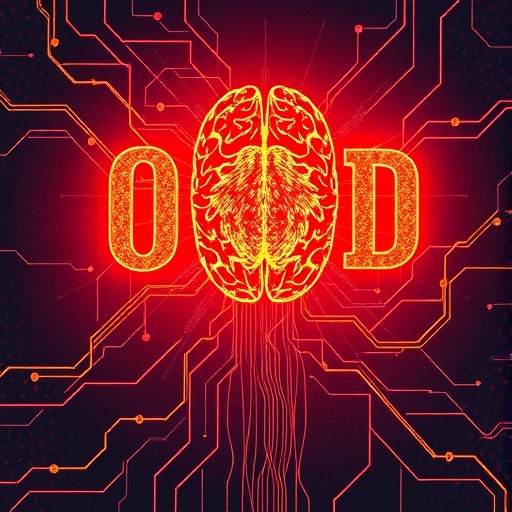In recent years, the intricate workings of the human brain have been a focal point for understanding complex neuropsychiatric disorders. Among these, obsessive-compulsive disorder (OCD) stands out as a debilitating condition characterized by persistent intrusive thoughts and repetitive behaviors. A groundbreaking study published in Nature Communications sheds unprecedented light on the dynamic neural mechanisms underpinning OCD, revealing not only how frontostriatal circuits falter in this disorder but also proposing novel avenues for therapeutic intervention. This research marks a significant leap forward in decoding the brain’s malfunctioning circuitry and outlines promising strategies to restore healthy neural dynamics.
Central to their findings is the concept of neural dynamics—how patterns of activity evolve across time within key brain circuits. Unlike static snapshots of brain activity typically captured by traditional imaging, neural dynamics provide a fluid and nuanced picture of brain function, revealing how abnormalities arise within the flow of information between regions. The researchers demonstrated that in OCD, the balance and timing of activity within frontostriatal loops are disrupted, leading to enhanced signal reverberation that may underlie the persistence of compulsive thoughts and actions. This revelation offers a mechanistic explanation for longstanding clinical observations and guides targeted interventions.
.adsslot_3YpTitRQ4L{ width:728px !important; height:90px !important; }
@media (max-width:1199px) { .adsslot_3YpTitRQ4L{ width:468px !important; height:60px !important; } }
@media (max-width:767px) { .adsslot_3YpTitRQ4L{ width:320px !important; height:50px !important; } }
ADVERTISEMENT
The study’s methodology represents a fusion of cutting-edge technologies. Functional magnetic resonance imaging (fMRI) was employed to quantify brain activity patterns during cognitive tasks designed to probe inhibitory control and habit formation—two domains compromised in OCD. Complementing imaging data, the team utilized computational models that simulate the interaction dynamics of neuronal populations within frontostriatal circuits. By integrating empirical data with simulation, they could dissect the causal relationships driving pathological network behavior, moving beyond correlation toward mechanistic understanding.
One of the most exciting aspects of this research lies in its exploration of therapeutic interventions aimed at normalizing frontostriatal dynamics. The authors tested various neuromodulatory techniques, including transcranial magnetic stimulation (TMS) and deep brain stimulation (DBS), both of which have emerged as powerful tools to modulate neural activity non-invasively or invasively. Their computational framework enabled prediction of how specific stimulation parameters could restore balance to dysregulated circuits, offering a personalized approach to treatment based on an individual’s unique neural signature.
Crucially, the researchers found that effective intervention requires not simply dampening hyperactivity or boosting hypoactivity but recalibrating the temporal coordination of signaling within the frontostriatal pathways. This nuanced approach addresses the core problem of dysfunctional timing rather than focusing solely on activity magnitude. Such insight could revolutionize current clinical practices, shifting therapeutic paradigms toward circuit dynamics and temporal precision.
Beyond neuromodulation, the study also investigated pharmacological strategies that target neurotransmitter systems integral to frontostriatal function, particularly dopamine and glutamate. By modulating these chemical messengers, it might be possible to fine-tune circuit dynamics pharmacologically. The integration of pharmacological data within their computational model allowed the team to predict how certain drugs could synergize with neuromodulation to amplify therapeutic effects, potentially heralding multimodal treatment regimens for OCD.
The implications of this research resonate beyond obsessive-compulsive disorder itself. Frontostriatal circuits are implicated in a range of neuropsychiatric conditions, including addiction, schizophrenia, and Parkinson’s disease. Understanding how to manipulate their dynamics with precision opens doors to broad-spectrum applications. Furthermore, the methodological blueprint combining imaging, computational modeling, and intervention testing can be adapted to examine other brain networks affected in diverse disorders, signaling a new era of circuit-based neuroscience.
Despite these advances, the authors emphasize the complexity of translating findings from laboratory models to clinical realities. Individual variability in brain structure and function, coupled with the heterogeneity inherent in OCD symptoms, poses significant challenges. Nevertheless, the personalized medicine approach championed here—grounding interventions in patient-specific neural data—offers hope for more effective, tailored therapies that can improve outcomes where current treatments fall short.
The study’s approach underscores the necessity for longitudinal studies to track how frontostriatal dynamics evolve with disease progression and treatment. Such insights could enable early detection of dysfunction and preemptive intervention, potentially mitigating the severity of OCD before entrenched pathological patterns take hold. Monitoring neural dynamics over time will also help refine and optimize therapeutic protocols, ensuring sustained benefit and reducing relapse.
Moreover, the research broadens the conversation surrounding mental health disorders, emphasizing the biological and circuit-based underpinnings rather than attributing symptoms solely to psychological or environmental factors. By illuminating the neural mechanics at play, these findings contribute to destigmatization and encourage development of scientifically informed treatments grounded in neurobiology.
From a technological perspective, this study showcases the power of interdisciplinary collaboration, melding neuroimaging, computational neuroscience, and clinical intervention. Progress in neuropsychiatric treatment increasingly depends on such integrative approaches that transcend traditional disciplinary boundaries, harnessing large-scale data analysis and advanced simulation to unravel the brain’s mysteries.
In summation, Naze and colleagues’ pioneering work reveals the dynamic, time-sensitive disruptions within frontostriatal circuits that fuel obsessive-compulsive disorder. It offers a roadmap for restoring healthy brain function through targeted neuromodulation and pharmacotherapy informed by computational modeling. This paradigm not only transforms our understanding of OCD but sets a precedent for tackling complex brain disorders through precision circuit modulation.
Subject of Research: Neural mechanisms and therapeutic interventions targeting frontostriatal dynamics in obsessive-compulsive disorder.
Article Title: Mechanisms and interventions promoting healthy frontostriatal dynamics in obsessive-compulsive disorder.
Article References:
Naze, S., Hearne, L.J., Sanz-Leon, P. et al. Mechanisms and interventions promoting healthy frontostriatal dynamics in obsessive-compulsive disorder.
Nat Commun 16, 7400 (2025). https://doi.org/10.1038/s41467-025-62190-2
Image Credits: AI Generated
Tags: advanced neuroimaging techniquesbrain connectivity and functioncognitive and motor functionscompulsive behaviors in OCDcomputational modeling in neurosciencefrontostriatal healthNaze study on OCDneural mechanisms of OCDneuropsychiatric disordersObsessive Compulsive Disorder researchrestoring healthy neural dynamicstherapeutic interventions for OCD





